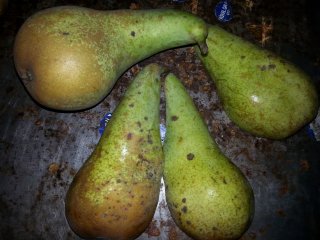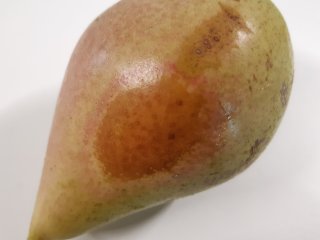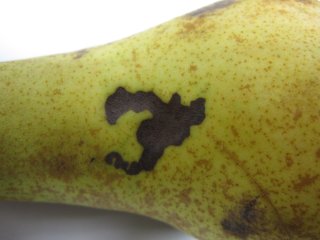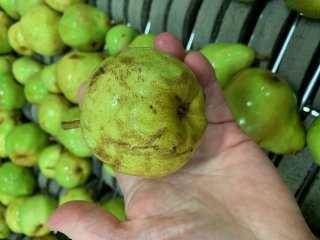
Pear disorders
The most common pear disorders are shown on this page.
Overview of pear disorders
-

Pear scab. Photo by WUR Pear scab
Pear scab is caused by the fungus Venturia. It can resemble a dark skin wart or shows as several small black spots. It is usually already visible at harvest, but can also develop during storage from earlier infections and is then called: storage scab. Scab is most common on organically grown fruit. -

Sunburn. Photo by WUR Sunburn
Sunburn on pears is caused by bright sun and high temperatures in the orchard before or shortly after harvest. The affected spot on the pear is usually only slightly discoloured. But in more serious cases, the burnt skin becomes browner or even black. -
First signs of shrivelling are often visible at the neck of the pear . Photo by WUR Shrivelling
Shrivelling is the consequence of too much water loss of the pear. Some water loss is not a problem but when it becomes above approximately 3%, shrivelling of the skin appears. The first symptoms usually begin at the neck (near the stem) in the case of elongated pears. Small pears shrivel more easily than large pears. To avoid shriveling, a low and stable temperature and high humidity during storage will help. -

Soft scald. Photo by WUR Soft scald
Soft scald is known for the variety Abate Fetel. It has typical symptoms. The affected skin is soft and smooth and shows an irregular ribbon-like brown area with sharp edges. It can extend a few millimeters into the flesh that becomes brown and soft. This disorders is related to storage under low O2 (CA storage). -

Superficial scald. Photo by WUR Superficial scald
Superficial scald, also called common scald, is a disorder that is visible on the skin. It looks like a brown stain with no clear edges. The flesh under the skin is not affected. This disorder can get worse during storage and especially during shelf-life. Therefore, it may appear unexpectedly after a few days on the shelf. However, the cause lies earlier in the supply chain. Low temperature and low oxygen during storage and application of 1-MCP can reduce the risk. -
Glassy tissue due to freezing. Photo by WUR Freezing injury
Freezing injury can be serious. Pears may be able to withstand several days or even weeks at -2 °C (28 °F) or lower, but are irreversibly damaged when the frost is more severe. The frozen tissue has a glassy appearance that can be limited to the neck and outer parts of the pear. From the outside, the skin looks dark. In moderate cases, a slow warming can save the pears. But in more severe cases the flesh soon becomes watery, soft and with a brownish colour after thawing. -
Brown core. Photo by WUR Brown core
Brown core is an internal disorder seen under Controlled Atmosphere storage. The symptoms are visible only after cutting the fruit. It is often referred to as a CO2 injury. But the susceptibility to CO2 injury increases with a lower O2, so the ratio between O2 and CO2 is important. This injury starts with browning in tissue around the core. In this area, cavities can develop later when the tissue dries out. The susceptibility to this disorder increases with a higher maturity at harvest. -
Senescence browning. Photo by WUR Senescence browning
Senescence browning is associated with soft and brown tissue. Pears with senescence breakdown have been stored under suboptimal conditions such as too high temperature or are simply stored for too long. The risk on senescence browning increases when pears are harvested beyond the optimum maturity for long-term storage. -

Skin damage. Photo by WUR Skin damage
Skin damages due to sorting can make the pears very unattractive. Smooth-skinned pears are easily damaged and some varieties are particularly sensitive, such as Beurré Alexander Lucas. To reduce the risk of sorting damage, pears are often warmed up a few degrees after cold storage before sorting begins. Application of 1-MCP reduces the sensitivity in skin damage. The sorting line should have smooth surfaces, no hard brushes, and an appropriate speed.